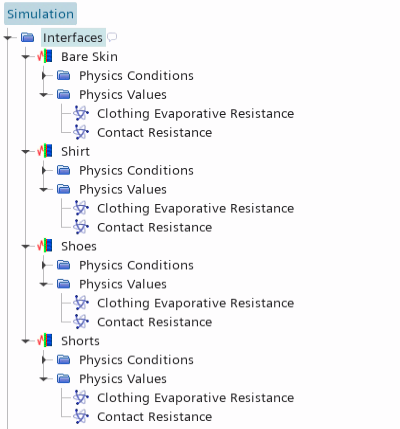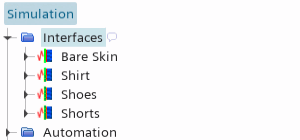Creating Interfaces between the Manikin and Cabin Regions
To simulate the thermal regulation of the manikin, you require thermal network interfaces between the fluid region for the cabin and the thermal network region for the manikin.
To differentiate between bare skin and clothes, you create interfaces for the part surfaces that represent bare skin, such as the head and hands, and for the part surfaces that are covered with clothes. In this tutorial, you also specify different clothing evaporative resistance and contact resistance values for different items of clothing, therefore, you require a separate interface for each item.
-
Create the interfaces between the Manikin and
Cabin regions. For this simulation, the manikin is
wearing a shirt, shorts and trainers. Therefore, you require four different
interfaces:
-
Expand the Interfaces node and set the following
properties:
Node Property Setting Shirt Contacts - Cabin.Driver.Abdomen_Back/Abdomen_Back
- Cabin.Driver.Abdomen_Front_L/Abdomen_Front_L
- Cabin.Driver.Abdomen_Front_R/Abdomen_Front_R
- Cabin.Driver.L_Arm_Back_L/L_Arm_Back_L
- Cabin.Driver.L_Arm_Back_R/L_Arm_Back_R
- Cabin.Driver.L_Arm_Front_L/L_Arm_Front_L
- Cabin.Driver.L_Arm_Front_R/L_Arm_Front_R
- Cabin.Driver.L_Shoulder/L_Shoulder
- Cabin.Driver.R_Arm_Back_L/R_Arm_Back_L
- Cabin.Driver.R_Arm_Back_R/R_Arm_Back_R
- Cabin.Driver.R_Arm_Front_L/R_Arm_Front_L
- Cabin.Driver.R_Arm_Front_R/R_Arm_Front_R
- Cabin.Driver.R_Shoulder/R_Shoulder
- Cabin.Driver.Thorax_Back/Thorax_Back
- Cabin.Driver.Thorax_Front_L/Thorax_Front_L
- Cabin.Driver.Thorax_Front_R/Thorax_Front_R

Value 6.5 Pa-m^2/W 
Value 0.077 m^2-K/W Shoes Contacts - Cabin.Driver.L_Foot_Sole/L_Foot_Sole
- Cabin.Driver.L_Foot_Top/L_Foot_Top
- Cabin.Driver.R_Foot_Sole/R_Foot_Sole
- Cabin.Driver.R_Foot_Top/R_Foot_Top

Value 18.2 Pa-m^2/W 
Value 0.096 m^2-K/W Shorts Contacts - Cabin.Driver.L_Thigh_Back_L/L_Thigh_Back_L
- Cabin.Driver.L_Thigh_Back_R/L_Thigh_Back_R
- Cabin.Driver.L_Thigh_Front_L/L_Thigh_Front_L
- Cabin.Driver.L_Thigh_Front_R/L_Thigh_Front_R
- Cabin.Driver.Pelvis_Bottom/Pelvis_Bottom
- Cabin.Driver.Pelvis_L/Pelvis_L
- Cabin.Driver.Pelvis_R/Pelvis_R
- Cabin.Driver.R_Thigh_Back_L/R_Thigh_Back_L
- Cabin.Driver.R_Thigh_Back_R/R_Thigh_Back_R
- Cabin.Driver.R_Thigh_Front_L/R_Thigh_Front_L
- Cabin.Driver.R_Thigh_Front_R/R_Thigh_Front_R

Value 6.0 Pa-m^2/W 
Value 0.062 m^2-K/W Bare Skin Contacts Select the remaining 27 Cabin Wrap/Driver Contacts. Include the contacts for the following body parts: - Face
- Head
- Left Calf
- Left Forearm
- Left Hand
- Neck
- Right Calf
- Right Forearm
- Right Hand
The values specified for clothing evaporative resistance and contact resistance come from experimental data [960]. You do not need to set these values for the bare skin interface. Simcenter STAR-CCM+ automatically accounts for this with the default value of 0.0 Pa-m^2/ W for Clothing Evaporative Resistance and 0.0 m^2-K/ W for Contact Resistance.

- Save the simulation.
